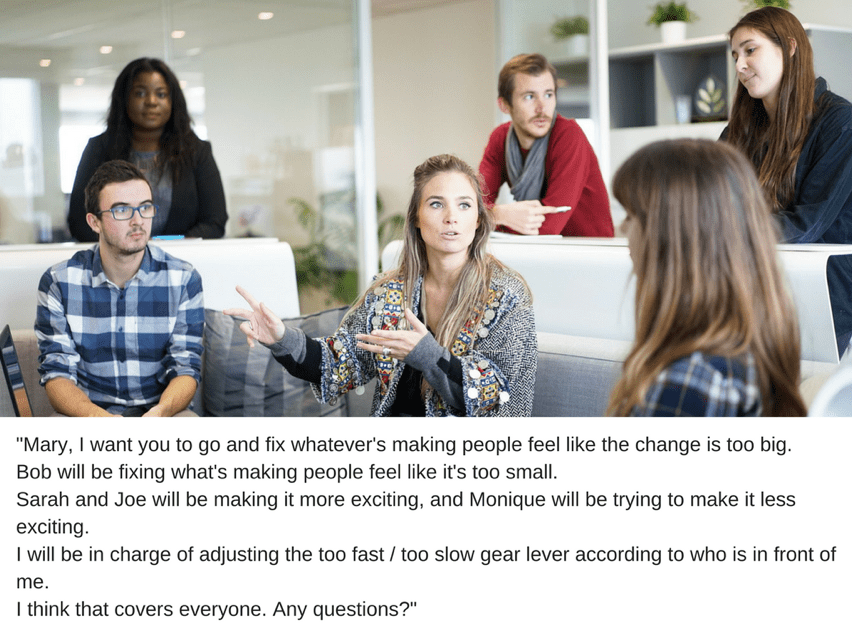This series of articles is best read in order, so if you haven’t read article 1, article 2.1 or article 2.2 yet, I invite you to head over and do that first.
One of the things we tend to take for granted while the organisation or team is undergoing a major change is that people’s performance (and therefore that of the organisation) will always take a hit during this time. When a change project can last a number of years, that’s a long time to accept a performance dip as inevitable.
Given that one change project is often followed by another, does this mean that we’re destined never to achieve top performance, because we’re always in a state of change?
Not when you see that the equation:
change = drop in performance
is a faulty one. It’s a correlation that people have mistakenly taken for causation.
So rather than tips and strategies that have sprung up from accepting a faulty equation (such as ‘5 top tips for keeping performance up in times of change’) what I will give you in this article is a way to help people understand and navigate change such that they see that their performance is not at the mercy of what’s going on around them.
On one hand, you’ll be able to ‘unhook’ the false cause/effect relationship between change and performance; on the other hand, ‘we’re going through change’ will no longer be an excuse for low performance.
So if you’re ready for that, let’s begin!
What does low performance look like?
Before we start to look at the real cause of any drop in performance during times of change, let’s take a look at the symptoms that come together as what we term ‘low performance’.
Here are some examples:
- Low morale
- Lack of engagement
- Passive or active resistance to the change
- Lack of clarity
- Lack of trust
- Poor quality of work
When we think that these are an inevitable result of going through a change process, we put ourselves in the position of believing we are at the mercy of our circumstances, both as individuals and as an organisation. In that position, we think we either need to change the circumstances or attempt to change the way people view the circumstances – that is, try and give them a different perspective – in order to help them accept, move forward and lift their performance.
Either way, we are acting on the false premise that the change itself has the power to make people feel the way they’re feeling. When we think that’s true, we can end up with a list of 50 things to try and influence (because everyone’s got different reasons why the change is making them perform poorly), in order to make 25 people feel differently about the change and thereby perform better.

But the logic doesn’t stand up.
If change had the power to make people feel a certain way (x), it wouldn’t discriminate. We would feel (x), full-time until the circumstances altered in some way, then we would feel (y), corresponding to that set of circumstances. We don’t. There are infinite ways to feel about a change, and infinite variations in one person’s experience over time, even when the situation remains the same. I know you have experienced this for yourself, and seen it in others.
When we truly understand that symptoms of low morale, poor work quality or counter-productive behaviours are nothing to do with the change itself, but everything to do with how clearly (or not) our people see that their feelings are coming from their thinking in each moment, and not from the circumstances, intervention becomes far simpler. We have only one point to focus on:
Showing people where their feelings and perceptions are really coming from.
That’s not to say there aren’t things that could be done better within the change process, from a technical, communication or leadership perspective; however, if people understand that those things aren’t responsible for how they feel, they are free to give and receive feedback and assess those aspects of the change more objectively. They are able to take action to improve them without being hijacked by their emotional experience.
Here are some examples, in the context of performance, of the implications of understanding where our experience is coming from.
|
Believes the situation is causing their experience |
Understands their experience is 100% caused by Thought in each moment |
|
Acts on feelings of resentment or frustration (passive or aggressive resistance) |
Sees those feelings as a reflection of their thinking in that moment, therefore not compelled to act on them; more likely to take constructive action to understand reasons behind decisions |
|
Is in a position of ‘victim’ and feels helpless |
Is open to possibilities and opportunities; perceives choices |
|
Sees obstacles |
Seeks alternatives or improvements |
|
Lacks trust – finds sinister reasons for decisions |
Trusts that intentions are generally honest, even if he or she doesn’t agree |
|
Loses focus on tasks at hand as they believe their feelings of overwhelm are an indicator of the seriousness of their situation |
Understands that he or she is free to perform even when not feeling clear, as they know those feelings aren’t telling them about the situation |
|
Sees change as scary, overwhelming or disruptive |
Understands that change has no inherent properties and is part of the normal cycle of business (and life). |
|
Sees change as a ‘thing’ that is separate from his or her job |
Understands that it is ‘part of the job’ rather than an interruption to the job. |
Of course, even those who are very grounded in their understanding of the nature and role of Thought will fall into the trap of thinking that their feelings are coming from somewhere other than thought in any moment. That’s a completely normal and natural result of the deceptive nature of the human experience. Now you see it, now you don’t.
When you’ve got a whole team or a whole company grounded in this understanding, however, you’ve got a support network that will understand what’s going on for that person and point them back in the direction of how life really works.
The tide of clarity, wellbeing and trust within the organisation will rise, change will start to look like a normal part of the job, and as a natural outcome, performance will no longer be seen as at the mercy of the level of change taking place at any time.
In the next article, we’ll see what’s missing from the change models that’s the key to unlocking the hidden potential of your organisation as it navigates change.
This article is brought to you exclusively by The Business Transformation Network.


